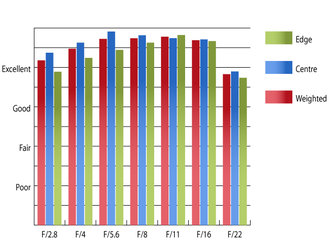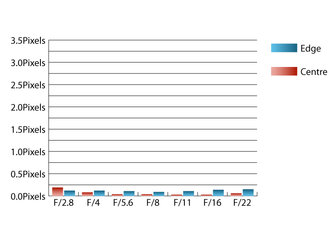Canon EF 300mm f/2.8L IS II USM Lens Review
Canon EF 300mm f/2.8L IS II USM Performance
Optically, this lens puts in a superb performance. At f/2.8 sharpness in the centre of the frame is already approaching outstanding levels and towards the edges the clarity just falls short of excellent. Stopping down improves sharpness to outstanding levels across the frame between f/8 and f/11. | How to read our chartsThe blue column represents readings from the centre of the picture frame at the various apertures and the green is from the edges. Averaging them out gives the red weighted column.The scale on the left side is an indication of actual image resolution. The taller the column, the better the lens performance. Simple. For this review, the lens was tested on a Canon EOS 5D MkII using Imatest. |
Chromatic aberrations barely figured in testing, with all values recorded during testing remaining well under a quarter of a pixel width. This extremely low level of fringing should not be noticeable, even in very large prints, or harsh crops from near the edges of the frame.
 | How to read our chartsChromatic aberration is the lens' inability to focus on the sensor or film all colours of visible light at the same point. Severe chromatic aberration gives a noticeable fringing or a halo effect around sharp edges within the picture. It can be cured in software.Apochromatic lenses have special lens elements (aspheric, extra-low dispersion etc) to minimize the problem, hence they usually cost more. For this review, the lens was tested on a Canon EOS 5D MkII using Imatest. |
Falloff of illumination towards the corners of the frame is quite well-controlled for a fast super-telephoto lens such as this. At f/2.8 the corners at 1.78 stops darker than the image centre and visually uniform illumination is realised when stopped down to f/5.6 or beyond.
Pincushion distortion is present in images taken with this lens, but if you're able to spot 0.0381% pincushion distortion, then you'll be glad to know that this low level is uniform across the frame, so should be relatively easy to correct in image editing software afterwards.
A whopping-huge bin-type lens hood is supplied with the lens along with a flight case for transportation and a sock-type lens cap. This lens can happily be used without the lens hood attached as it is very resistant to flare and contrast levels remain high, even when shooting into the light. It seems the sub-wavelength coating applied does an excellent job.
Add your message
Login required
Please login here or if you've not registered, you can register here. Registering is safe, quick and free.
Please login here or if you've not registered, you can register here. Registering is safe, quick and free.
photodo Stats
1102 lenses
428 MTF tests
74 in-depth photodo reviews
100+ users join each day
Help the lens community by reviewing or rating a lens today via our lens search
428 MTF tests
74 in-depth photodo reviews
100+ users join each day
Help the lens community by reviewing or rating a lens today via our lens search
Latest Lens Reviews
- Chinon 28mm f/2.8 Vintage Lens Review
- Canon EF 70-200mm f/4L IS II USM Lens Review
- Samyang AF 85mm f/1.4 EF Review
- Sigma 70mm f/2.8 DG Macro Art Review
- Samyang AF 24mm f/2.8 FE Review
- Meike 50mm f/1.7 Review
- Tamron 70-210mm f/4 Di VC USD Review
- Lensbaby Burnside 35mm f/2.8 Review
- Asahi Super Takumar 50mm f/1.4 Review
- Asahi Super-Multi-Coated Takumar 135mm f/3.5 Review
